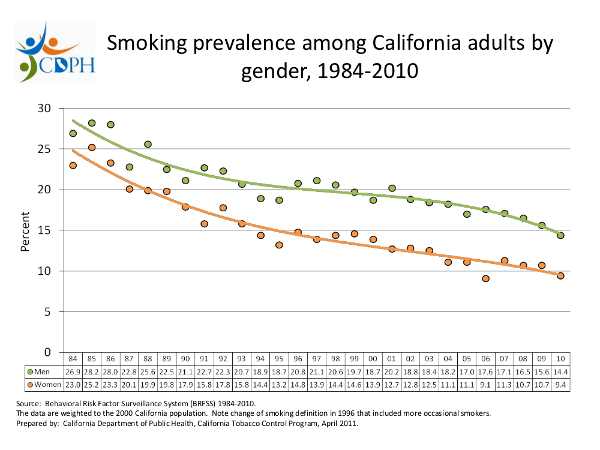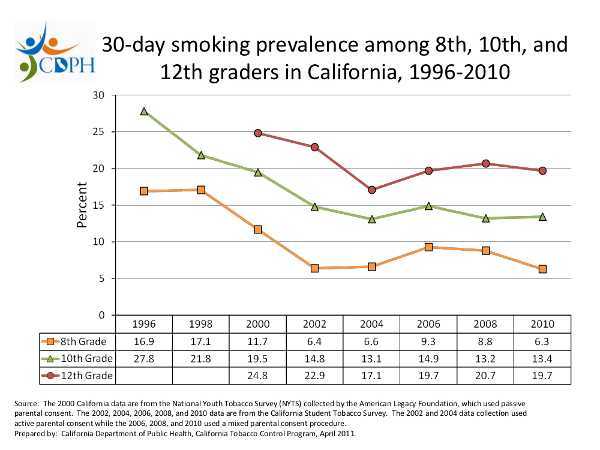- Elizabeth Larson
- Posted On
Smoking rates for California's adults hit historic low while local rates remain high

LAKE COUNTY, Calif. – A new state report shows that the rate of smoking among California's adults has hit an all-time low, while Lake County's adult smoking rate is nearly twice the state average, which the county health officer called a “glaring problem.”
California Department of Public Health Director Dr. Ron Chapman issued the report late last week, drawing the data from the Centers for Disease Control’s Behavioral Risk Factor Surveillance System.
The state's data showed that, in 2010, 11.9 percent of the state’s adults smoked, down from 13.1 percent in 2009.
Health officials said California was one of only two states to reach the federal Healthy People 2020 target of reducing the adult smoking prevalence rate to 12 percent.
“The drop in smoking means that fewer people will see their lives cut short by tobacco,” Chapman said. “Since the inception of California’s tobacco education efforts in 1990, we have witnessed declines in lung cancer, heart disease and other tobacco-related illnesses.”
While California has managed to reduce its smoking rates, Chapman said the state still has to continue its aggressive efforts.
“While we take great pride in seeing smoking decrease nearly 10 percent in just one year, smoking remains the number one preventable cause of death and disease, killing more than 400,000 Americans each year,” Chapman said.
In 2010, 14.4 percent of men and and 9.4 percent of women smoked in California, down from the previous year, when 15.6 percent of men and 10.7 percent of women smoked, the report stated.

The California Department of Public Health also reported that smoking rates declined among all age groups, with the most significant decrease occurring among adults ages 25 to 44, which fell from 15.2 percent in 2009 to 13.1 percent in 2010.
In Lake County, the state's findings regarding adult smokers were not as positive.
Among the county's estimated 51,000 adults, 10,000 people – or 20.1 percent – smoke, according to data the California Department of Public Health provided to Lake County News.
In neighboring Mendocino County, the state said that adult smokers total 12,000, or 17.6 percent of the population.
“Our smoking rates are not doing so well,” said Lake County Health Officer Dr. Karen Tait.
Those numbers are, however, better than the conclusion arrived at by the 2010 Lake County Community Health Needs Assessment.
That report, drawing on 2007 data from the California Health Interview Survey, showed that 14.5 percent of California adults smoked, compared to 25.9 percent of Lake County adults.
Comparing that data to the newest report, Tait said that while local smoking rates are still high, they may be showing a slight improvement.
“We may be following the trend but I think we're lagging, and we need to do much better,” Tait said.
The state also reported that smoking among high school students decreased from 14.6 percent in 2008 to 13.8 percent in 2010, while middle school student smoking decreased from 6.0 percent in 2008 to 4.8 percent in 2010. The 2010 youth smoking prevalence rate is taken from the biennial in-school California Student Tobacco Survey.
The state did not include specific numbers by counties on children who smoke, but Tait drew on data from www.kidsdata.org to offer a comparison between Lake County children who admitted smoking and the statewide numbers.
Between 2004 and 2008, children in Lake County who admitted smoking included 4.7 percent of seventh graders, 19 percent of ninth graders and 22.6 percent of 11th graders.
“I find that kind of alarming,” she said.
As for the reasons why Lake County's overall smoking rates are higher, Tait said both poverty and rural settings have been linked to higher smoking rates.
But as to why that is, Tait couldn't say.
“I haven't really heard a scientific explanation for that,” she said. “Some of us have speculated.”
Regarding children, Tait said young people sometimes engage in mind-altering behaviors – smoking among them – which she guesses is to address feelings they have. “But that is just speculation,” she added.
Tait said smoking is the No. 1 preventable risk factor for many diseases – including cancer and heart disease – so smoking cessation is something “that's well worth putting effort towards.”
However, there doesn't appear to be strong interest in smoking cessation in Lake County, according to Glenn Koeppel, who works in Lake Family Resource Center's Tobacco Education Program.
Koeppel said that, despite the fact that smoking is becoming more cost prohibitive, he's found that the worse off people are economically, the more they tend to continue to smoke.
He said he gets very low turnout at smoking cessation classes he leads. At one recent evening class in Lakeport – scheduled so people could make it after work – only one person showed up, and that individual wasn't able to finish the course.
“There doesn't even seem to be a desire in Lake County for people who want to quit,” Koeppel said.
While everyone knows the health challenges connected to smoking, “It doesn't seem to be much of a deterrent,” he said.
E-mail Elizabeth Larson at This email address is being protected from spambots. You need JavaScript enabled to view it.. Follow Lake County News on Twitter at http://twitter.com/LakeCoNews, on Tumblr at www.lakeconews.tumblr.com, on Facebook at http://www.facebook.com/pages/Lake-County-News/143156775604?ref=mf and on YouTube at http://www.youtube.com/user/LakeCoNews.

 How to resolve AdBlock issue?
How to resolve AdBlock issue? 







